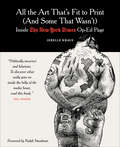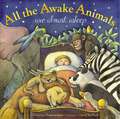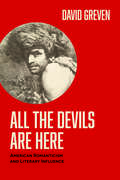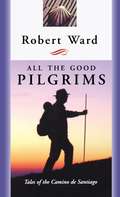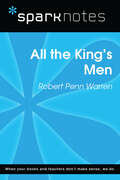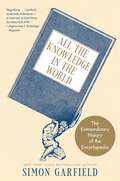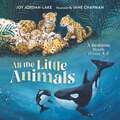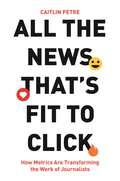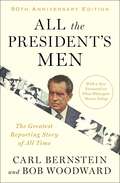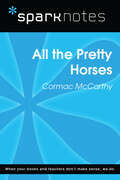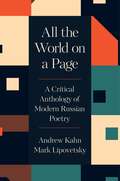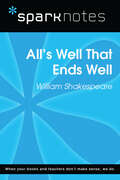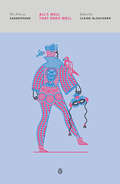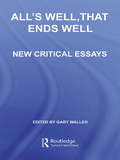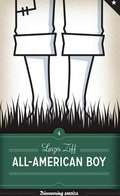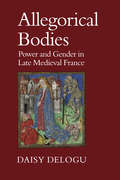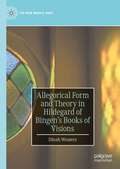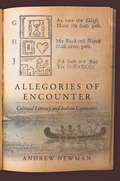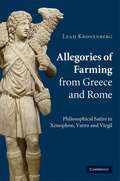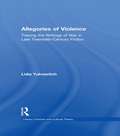- Table View
- List View
All the Art That's Fit to Print (And Some That Wasn't): Inside The New York Times Op-Ed Page
by Jerelle KrausFrom the New York Times&’s former Op-Ed art director, the true story of the world&’s first Op-Ed page, a public platform that prefigured the blogosphere. Jerelle Kraus, whose thirteen-year tenure as Op-Ed art director far exceeds that of any other art director or editor, unveils a riveting account of working at the Times. Her insider anecdotes include the reasons why artist Saul Steinberg hated the Times, why editor Howell Raines stopped the presses to kill a feature by Doonesbury&’s Garry Trudeau, and why reporter Syd Schanburg—whose story was told in the movie The Killing Fields—stated that he would travel anywhere to see Kissinger hanged, as well as Kraus&’s tale of surviving two and a half hours alone with the dethroned outlaw, Richard Nixon. All the Art features a satiric portrayal of John McCain, a classic cartoon of Barack Obama by Jules Feiffer, and a drawing of Hillary Clinton and Obama by Barry Blitt. But when Frank Rich wrote a column discussing Hillary Clinton exclusively, the Times refused to allow Blitt to portray her. Nearly any notion is palatable in prose, yet editors perceive pictures as a far greater threat. Confucius underestimated the number of words an image is worth; the thousand-fold power of a picture is also its curse . . . Features 142 artists from thirty nations and five continents, and 324 pictures—gleaned from a total of 30,000—that stir our cultural-political pot. &“To discover what really goes on inside the belly of the media beast, read this book.&” —Bill Maher &“In this overflowing treasure chest of ideas, politics and cultural critiques, Kraus proves that &“art is dangerous&” and sometimes necessarily so.&” —Publishers Weekly
All the Awake Animals are Almost Asleep
by Crescent DragonwagonAn alphabet of animals prepare to go to sleep.
All the Devils Are Here: American Romanticism and Literary Influence
by David GrevenThe English literary influence on classic American novelists&’ depictions of gender, sexuality, and race With All the Devils Are Here, the literary scholar David Greven makes a signal contribution to the growing list of studies dedicated to tracing threads of literary influence. Herman Melville&’s, Nathaniel Hawthorne&’s, and James Fenimore Cooper&’s uses of Shakespeare and Milton, he finds, reflect not just an intertextual relationship between American Romanticism and the English tradition but also an ongoing engagement with gender and sexual politics. Greven limns the effect of Shakespeare&’s Much Ado about Nothing on Hawthorne&’s exploration of patriarchy, and he shows how misogyny in King Lear informed Melville&’s evocation of &“the step-mother world&” of orphaned men in Moby-Dick. Throughout, Greven focuses particularly on male authors&’ treatment of femininity, arguing that the figure of woman functions for them as a multivalent signifier for artistic expression. Ultimately, Greven demonstrates the ambitions of these writers to comment on the history of the Western tradition and the future of art from their unique positions as Americans.
All the Good Pilgrims: Tales of the Camino de Santiago
by Robert WardRobert Ward has always enjoyed travelling, especially on foot. When he discovered the ancient pilgrimage route to Santiago in Spain, he felt compelled to walk and experience this historic road. From his first journey along the Camino de Santiago, Ward fell in love with the pace, landscape, history, art, and romance of this old pilgrimage path. Above all, however, Ward fell in love with the people of the Camino – both the welcoming Spaniards and the pilgrims who come from all over the world to find out what it means to travel five hundred miles, one step at a time. In All the Good Pilgrims, Ward returns to Spain to walk the Camino for the fifth time. He thinks he knows what he’s getting into but, as his many Camino journeys have taught him, the Camino never runs out of surprises. Each day brings new lessons, friendships, questions, memories, gifts and challenges, reminding Ward that it isn’t the pilgrim who walks the Camino – it’s the Camino that walks the pilgrim. An engaging travel narrative, All the Good Pilgrims is a personal and insightful tour of the Camino de Santiago, as Ward takes readers on a secular pilgrimage in which he reflects on his past journeys and contemplates the mysterious and enduring allure of this ancient and historic road.
All the King's Men (SparkNotes Literature Guide Series)
by SparkNotesAll the King's Men (SparkNotes Literature Guide) by Robert Penn Warren Making the reading experience fun! Created by Harvard students for students everywhere, SparkNotes is a new breed of study guide: smarter, better, faster. Geared to what today's students need to know, SparkNotes provides: chapter-by-chapter analysis explanations of key themes, motifs, and symbols a review quiz and essay topics Lively and accessible, these guides are perfect for late-night studying and writing papers.
All the Knowledge in the World: The Extraordinary History of the Encyclopedia
by Simon GarfieldFrom the “deliriously clever” (Boston Globe) Simon Garfield, New York Times bestselling author of Just My Type, comes the wild and fascinating story of the encyclopedia, from Ancient Greece to the present day."A brilliant book about knowledge itself.” —Deirdre Mask, author of The Address Book"Magnificent. ... A perfectly styled work of literature – at times sad, at times funny, but always full of life." —Engineering & Technology MagazineThe encyclopedia once shaped our understanding of the world. Created by thousands of scholars and the most obsessive of editors, a good set conveyed a sense of absolute wisdom on its reader. Contributions from Albert Einstein, Sigmund Freud, Orville Wright, Alfred Hitchcock, Marie Curie and Indira Gandhi helped millions of children with their homework. Adults cleared their shelves in the belief that everything that was explainable was now effortlessly accessible in their living rooms.Now these huge books gather dust and sell for almost nothing on eBay. Instead, we get our information from our phones and computers, apparently for free. What have we lost in this transition? And how did we tell the progress of our lives in the past?All the Knowledge in the World is a history and celebration of those who created the most ground-breaking and remarkable publishing phenomenon of any age. Simon Garfield, who “has a genius for being sparked to life by esoteric enthusiasm and charming readers with his delight” (The Times), guides us on an utterly delightful journey, from Ancient Greece to Wikipedia, from modest single-volumes to the 11,000-volume Chinese manuscript that was too big to print. He looks at how Encyclopedia Britannica came to dominate the industry, how it spawned hundreds of competitors, and how an army of ingenious door-to-door salesmen sold their wares to guilt-ridden parents. He reveals how encyclopedias have reflected our changing attitudes towards sexuality, race, and technology, and exposes how these ultimate bastions of trust were often riddled with errors and prejudice.With his characteristic ability to tackle the broadest of subjects in an illuminating and highly entertaining way, Simon Garfield uncovers a fascinating and important part of our shared past and wonders whether the promise of complete knowledge—that most human of ambitions—will forever be beyond our grasp.
All the Little Animals: A Bedtime Book from A-Z
by Joy Jordan-LakeFrom armadillos to zokors and everything in between, you and your littles are invited to follow along as the animals of the world go to bed. Learn about their silly routines and their super-sweet snuggles as you tuck in and kiss your own little baby bears good night.Author Joy Jordan-Lake has brought to life her great-grandmother's tradition of putting the children to bed with this gentle litany. And illustrations by bestselling illustrator Jane Chapman make this bedtime book come to life.All the Little Animals: A Bedtime Book from A-Z is perfect forboys and girls ages 4 to 8 years old and families looking for a sweet and lyrical bedtime read,children interested in exploring the different types of animals around the world,bringing the zoo to you on rainy days, andteaching littles the alphabet.Start a new family tradition with All the Little Animals.
All the Lives We Ever Lived: Seeking Solace in Virginia Woolf
by Katharine SmythA wise, lyrical memoir about the power of literature to help us read our own lives—and see clearly the people we love most. Katharine Smyth was a student at Oxford when she first read Virginia Woolf’s modernist masterpiece To the Lighthouse in the comfort of an English sitting room, and in the companionable silence she shared with her father. After his death—a calamity that claimed her favorite person—she returned to that beloved novel as a way of wrestling with his memory and understanding her own grief. Smyth’s story moves between the New England of her childhood and Woolf’s Cornish shores and Bloomsbury squares, exploring universal questions about family, loss, and homecoming. Through her inventive, highly personal reading of To the Lighthouse, and her artful adaptation of its groundbreaking structure, Smyth guides us toward a new vision of Woolf’s most demanding and rewarding novel—and crafts an elegant reminder of literature’s ability to clarify and console. Braiding memoir, literary criticism, and biography, All the Lives We Ever Lived is a wholly original debut: a love letter from a daughter to her father, and from a reader to her most cherished author.
All the News That’s Fit to Click: How Metrics Are Transforming the Work of Journalists
by Caitlin PetreFrom the New York Times to Gawker, a behind-the-scenes look at how performance analytics are transforming journalism today—and how they might remake other professions tomorrowJournalists today are inundated with data about which stories attract the most clicks, likes, comments, and shares. These metrics influence what stories are written, how news is promoted, and even which journalists get hired and fired. Do metrics make journalists more accountable to the public? Or are these data tools the contemporary equivalent of a stopwatch wielded by a factory boss, worsening newsroom working conditions and journalism quality? In All the News That's Fit to Click, Caitlin Petre takes readers behind the scenes at the New York Times, Gawker, and the prominent news analytics company Chartbeat to explore how performance metrics are transforming the work of journalism.Petre describes how digital metrics are a powerful but insidious new form of managerial surveillance and discipline. Real-time analytics tools are designed to win the trust and loyalty of wary journalists by mimicking key features of addictive games, including immersive displays, instant feedback, and constantly updated “scores” and rankings. Many journalists get hooked on metrics—and pressure themselves to work ever harder to boost their numbers.Yet this is not a simple story of managerial domination. Contrary to the typical perception of metrics as inevitably disempowering, Petre shows how some journalists leverage metrics to their advantage, using them to advocate for their professional worth and autonomy.An eye-opening account of data-driven journalism, All the News That's Fit to Click is also an important preview of how the metrics revolution may transform other professions.
All the President's Men (Bloomsbury Film Classics Ser.)
by Bob Woodward Carl Bernstein50th Anniversary Edition—With a new foreword on what Watergate means today. &“The work that brought down a presidency...perhaps the most influential piece of journalism in history&” (Time)—from the #1 New York Times bestselling authors of The Final Days. The most devastating political detective story of the century: two Washington Post reporters, whose brilliant, Pulitzer Prize-winning investigation smashed the Watergate scandal wide open, tell the behind-the-scenes drama the way it really happened. One of Time magazine&’s All-Time 100 Best Nonfiction Books, this is the book that changed America. Published just months before President Nixon&’s resignation, All the President&’s Men revealed the full scope of the scandal and introduced for the first time the mysterious &“Deep Throat.&” Beginning with the story of a simple burglary at Democratic headquarters and then continuing through headline after headline, Bernstein and Woodward deliver a riveting firsthand account of their reporting. Their explosive reports won a Pulitzer Prize for The Washington Post, toppled the president, and have since inspired generations of reporters. All the President&’s Men is a riveting detective story, capturing the exhilarating rush of the biggest presidential scandal in US history as it unfolded in real time.
All the Pretty Horses (SparkNotes Literature Guide Series)
by SparkNotesAll the Pretty Horses (SparkNotes Literature Guide) by Cormac McCarthy Making the reading experience fun! Created by Harvard students for students everywhere, SparkNotes is a new breed of study guide: smarter, better, faster. Geared to what today's students need to know, SparkNotes provides: chapter-by-chapter analysis explanations of key themes, motifs, and symbols a review quiz and essay topics Lively and accessible, these guides are perfect for late-night studying and writing papers.
All the Strange Hours: The Excavation of a Life
by Loren C. EiseleyEiseley focuses not on the facts and linear details of his life but on how his ideas were formed and developed on class, identity, human tendencies, and relationships between humans and animals.
All the World on a Page: A Critical Anthology of Modern Russian Poetry
by Andrew Kahn Mark LipovetskyThe rich and ongoing development of Russian lyric poetry, explored through close readings of thirty-four poems by poets ranging from Alexander Blok to Maria StepanovaThe Russian cultural tradition treats poetry as the supreme artistic form, with Alexander Pushkin as its national hero. Modern Russian lyric poets, often on the right side of history but the wrong side of their country&’s politics, have engaged intensely with subjectivity, aesthetic movements, ideology (usually subversive), and literature itself. All the World on a Page gathers thirty-four poems, written between 1907 and 2022, presenting each poem in the original Russian and an English translation, accompanied by an essay that places the poem in its cultural, historical, and biographical contexts. The poems, both canonical and lesser-known works, extend across a range of moods and scenes: Velimir Khlebnikov&’s Futurist revolutionary prophecy, Anna Akhmatova&’s lyric cycle about poetic inspiration, Vladimir Nabokov&’s Symbolist erotic dreamworld, Joseph Brodsky&’s pastiche of a Chekhovian play set on a country estate, Maria Stepanova&’s pandemic allegory of political repression, Galina Rymbu&’s energetic manifesto &“My Vagina.&”An introduction explores the abiding inspiration of modernism on the Russian lyric tradition. Kahn and Lipovetsky's separate chapter essays, informed by extensive knowledge of the existing scholarship and critical styles of interpretation, consider how the interplay of originality and tradition and form and voice work to engage the reader. The poems themselves, many of them in newly commissioned translations, operate outside state-mandated poetic styles to address the reader directly, &“tête-à-tête,&” as Brodsky said in his 1987 Nobel lecture. With each chapter devoted to a different poem, All the World on a Page allows readers to experience the richness of Russian poetry through poems and poets rather than through movements.
All's Well That Ends Well (SparkNotes Literature Guide Series)
by SparkNotesAll's Well That Ends Well (SparkNotes Literature Guide) by William Shakespeare Making the reading experience fun! Created by Harvard students for students everywhere, SparkNotes is a new breed of study guide: smarter, better, faster. Geared to what today's students need to know, SparkNotes provides: chapter-by-chapter analysis explanations of key themes, motifs, and symbols a review quiz and essay topics Lively and accessible, these guides are perfect for late-night studying and writing papers.
All's Well That Ends Well (The Pelican Shakespeare)
by William ShakespeareThe acclaimed Pelican Shakespeare series edited by A. R. Braunmuller and Stephen Orgel The legendary Pelican Shakespeare series features authoritative and meticulously researched texts paired with scholarship by renowned Shakespeareans. Each book includes an essay on the theatrical world of Shakespeare&’s time, an introduction to the individual play, and a detailed note on the text used. Updated by general editors Stephen Orgel and A. R. Braunmuller, these easy-to-read editions incorporate over thirty years of Shakespeare scholarship undertaken since the original series, edited by Alfred Harbage, appeared between 1956 and 1967. With definitive texts and illuminating essays, the Pelican Shakespeare will remain a valued resource for students, teachers, and theater professionals for many years to come. For more than seventy years, Penguin has been the leading publisher of classic literature in the English-speaking world. With more than 1,700 titles, Penguin Classics represents a global bookshelf of the best works throughout history and across genres and disciplines. Readers trust the series to provide authoritative texts enhanced by introductions and notes by distinguished scholars and contemporary authors, as well as up-to-date translations by award-winning translators.
All's Well, That Ends Well: New Critical Essays (Shakespeare Criticism)
by Gary WallerDescribed as one of Shakespeare’s most intriguing plays, All’s Well That Ends Well has only recently begun to receive the critical attention it deserves. Noted as a crucial point of development in Shakespeare’s career, this collection of new essays reflects the growing interest in the play and presents a broad range of approaches to it, including historical, feminist, performative and psychoanalytical criticisms. In addition to fourteen essays written by leading scholars, the editor’s introduction provides a substantial overview of the play’s critical history, with a strong focus on performance analysis and the impact that this has had on its reception and reputation. Demonstrating a variety of approaches to the play and furthering recent debates, this book makes a valuable contribution to Shakespeare criticism.
All-American Boy
by Larzer ZiffFrom his celebrated appearance, hatchet in hand, in Parson Mason Locke Weems's Life of Washington to Booth Tarkington's Penrod, the all-American boy was an iconic figure in American literature for well over a century. Sometimes he was a "good boy," whose dutiful behavior was intended as a model for real boys to emulate. Other times, he was a "bad boy," whose mischievous escapades could be excused either as youthful exuberance that foreshadowed adult industriousness or as deserved attacks on undemocratic pomp and pretension. But whether good or bad, the all-American boy was a product of the historical moment in which he made his appearance in print, and to trace his evolution over time is to take a fresh view of America's cultural history, which is precisely what Larzer Ziff accomplishes in All-American Boy. Ziff looks at eight classic examples of the all-American boy-young Washington, Rollo, Tom Bailey, Tom Sawyer, Ragged Dick, Peck's "bad boy," Little Lord Fauntleroy, and Penrod-as well as two notable antitheses-Huckleberry Finn and Holden Caulfield. Setting each boy in a rich cultural context, Ziff reveals how the all-American boy represented a response to his times, ranging from the newly independent nation's need for models of democratic citizenship, to the tales of rags-to-riches beloved during a century of accelerating economic competition, to the recognition of adolescence as a distinct phase of life, which created a stage on which the white, middle class "solid citizen" boy and the alienated youth both played their parts.
Allegorical Bodies
by Daisy DeloguAllegorical Bodies begins with the paradoxical observation that at the same time as the royal administrators of late fourteenth and early fifteenth-century France excluded women from the royal succession through the codification of Salic law, writers of the period adopted the female form as the allegorical personification of France itself. Considering the role of female allegorical figures in the works of Eustache Deschamps, Christine de Pizan, and Alain Chartier, as well as in the sermons of Jean Gerson, Daisy Delogu reveals how female allegories of the Kingdom of France and the University of Paris were used to conceptualize, construct, and preserve structures of power during the tumultuous reign of the mad king Charles VI (1380-1422).An impressive examination of the intersection between gender, allegory, and political thought, Delogu's book highlights the importance of gender to the functioning of allegory and to the construction of late medieval French identity.
Allegorical Form and Theory in Hildegard of Bingen’s Books of Visions (The New Middle Ages)
by Dinah WoutersThis book analyses how the three books of visions by Hildegard of Bingen use the allegorical vision as a form of knowledge. It describes how the visionary’s use of allegory and allegorical exegesis is linked to theories of cognition, interpretation, and prophecy. It argues that the form of the allegorical vision is not just the product of a medieval symbolic mentality, but specific to Hildegard’s position and the major transformations taking place in the prescholastic intellectual milieu, such as the changing use of Scripture or the shift from traditional hermeneutics to cognitive language philosophy. The book shows that Hildegard uses traditional forms of knowledge – prophecy, the vision, monastic theology, allegorical hermeneutics – in startlingly innovative ways by combining them and by revising them for her own time.
Allegorical Moments: Call to the Everyday
by Lyn HejinianAllegorical Moments is a set of essays dedicated to rethinking allegory and arguing for its significance as a creative and critical response to sociopolitical, environmental, and existential turmoil affecting the contemporary world. Traditionally, allegorical interpretation was intended to express an orthodoxy and support an ideology. Hejinian attempts to liberate allegory from its dogmatic usages. Presenting modern and contemporary materials ranging from the novel to poetry to painting and cinema to activist poetry of the Occupy movement, each essay in the book "begins again" with different materials and from different perspectives. Hejinian's generative scholarship looks back to experimental modernism and forward into a future for a vital, wayward poetry resistant to the crushing global effects of neoliberalism.
Allegorical Readers and Cultural Revision in Ancient Alexandria
by David DawsonAllegorical readings of literary or religious texts always begin as counterreadings, starting with denial or negation, challenging the literal sense: "You have read the text this way, but I will read it differently." David Dawson insists that ancient allegory is best understood not simply as a way of reading texts, but as a way of using non-literal readings to reinterpret culture and society. Here he describes how some ancient pagan, Jewish, and Christian interpreters used allegory to endorse, revise, and subvert competing Christian and pagan world views.This reassessment of allegorical reading emphasizes socio-cultural contexts rather than purely formal literary features, opening with an analysis of the pagan use of etymology and allegory in the Hellenistic world and pagan opposition to both techniques. The remainder of the book presents three Hellenistic religious writers who each typify distinctive models of allegorical interpretation: the Jewish exegete Philo, the Christian Gnostic Valentinus, and the Christian Platonist Clement. The study engages issues in the fields of classics, history of Christianity and Hellenistic Judaism, literary criticism and theory, and more broadly, critical theory and cultural criticism.
Allegories of Encounter: Colonial Literacy and Indian Captivities (Published by the Omohundro Institute of Early American History and Culture and the University of North Carolina Press)
by Andrew NewmanPresenting an innovative, interdisciplinary approach to colonial America's best-known literary genre, Andrew Newman analyzes depictions of reading, writing, and recollecting texts in Indian captivity narratives. While histories of literacy and colonialism have emphasized the experiences of Native Americans, as students in missionary schools or as parties to treacherous treaties, captivity narratives reveal what literacy meant to colonists among Indians. Colonial captives treasured the written word in order to distinguish themselves from their Native captors and to affiliate with their distant cultural communities. Their narratives suggest that Indians recognized this value, sometimes with benevolence: repeatedly, they presented colonists with books.In this way and others, Scriptures, saintly lives, and even Shakespeare were introduced into diverse experiences of colonial captivity. What other scholars have understood more simply as textual parallels, Newman argues instead may reflect lived allegories, the identification of one's own unfolding story with the stories of others. In an authoritative, wide-ranging study that encompasses the foundational New England narratives, accounts of martyrdom and cultural conversion in New France and Mohawk country in the 1600s, and narratives set in Cherokee territory and the Great Lakes region during the late eighteenth century, Newman opens up old tales to fresh, thought-provoking interpretations.
Allegories of Farming from Greece and Rome
by Leah KronenbergIn this book Professor Kronenberg shows that Xenophon's Oeconomicus, Varro's De Re Rustica and Virgil's Georgics are not simply works on farming but belong to a tradition of philosophical satire which uses allegory and irony to question the meaning of morality. These works metaphorically connect farming and its related arts to political life; but instead of presenting farming in its traditional guise as a positive symbol, they use it to model the deficiencies of the active life, which in turn is juxtaposed to a preferred contemplative way of life. Although these three texts are not usually treated together, this book convincingly connects them with an original and provocative interpretation of their allegorical use of farming. It also fills an important gap in our understanding of the literary influences on the Georgics by showing that it is shaped not just by its poetic predecessors but by philosophical dialogue.
Allegories of Neoliberalism: Contemporary South Asian Fictions, Capital, and Utopia
by Sarker Hasan ZayedSimultaneously a critique of Foucauldian governmentalist interpretations of neoliberalism and a historical materialist reading of contemporary South Asian fictions, Allegories of Neoliberalism is a probing analysis of literary representations of capitalism’s “forms of appearance.” This book offers critical discussions on the important works of Akhtaruzzaman Elias, Amitav Ghosh, Aravind Adiga, Arundhati Roy, H. M. Naqvi, Mohsin Hamid, Nasreen Jahan, Samrat Upadhyay, and other writers from South Asia and South Asian diaspora. It also advances a re-reading of Karl Marx’s Capital through the themes and tropes of literature—one that looks into literary representations of commoditization, monetization, class exploitation, uneven spatial relationship, financialization, and ecological devastation through the lens of the German revolutionary’s critique of capitalism.
Allegories of Violence: Tracing the Writings of War in Late Twentieth-Century Fiction (Literary Criticism and Cultural Theory)
by Lidia YuknavitchAllegories of Violence demilitarizes the concept of war and asks what would happen if we understood war as discursive via late 20th Century novels of war.
